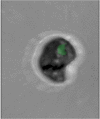A 2,000-year-old specimen with intraerythrocytic Bartonella quintana
- PMID: 32572066
- PMCID: PMC7308320
- DOI: 10.1038/s41598-020-66917-7
A 2,000-year-old specimen with intraerythrocytic Bartonella quintana
Abstract
Photogrammetry and cascading microscopy investigations of dental pulp specimens collected from 2,000-year-old individuals buried in a Roman necropolis in Besançon, France, revealed unprecedented preserved tissular and cellular morphology. Photogrammetry yielded 3-D images of the smallest archaeological human remains ever recovered. Optical microscopy examinations after standard haematoxylin-phloxine-saffron staining and anti-glycophorin A immunohistochemistry exposed dental pulp cells, in addition erythrocytes were visualised by electron microscopy, which indicated the ancient dental pulp trapped a blood drop. Fluorescence in situ hybridisation applied on red blood cells revealed the louse-borne pathogen Bartonella quintana, a finding confirmed by polymerase chain reaction assays. Through paleohistology and paleocytology, we demonstrate that the ancient dental pulp preserved intact blood cells at the time of the individual's death, offering an unprecedented opportunity to engage in direct and indirect tests to diagnose pathogens in ancient buried individuals.
Conflict of interest statement
The authors declare no competing interests.
Figures





References
-
- Moncel MH, Condemi S. Découverte de dents humaines dans le site Paléolithique moyen de Payre (Ardèche, France) Comptes rendus de l’Académie des sciences. Série 2. Sciences de la terre et des planètes. 1996;322:251–257.
LinkOut - more resources
Full Text Sources

